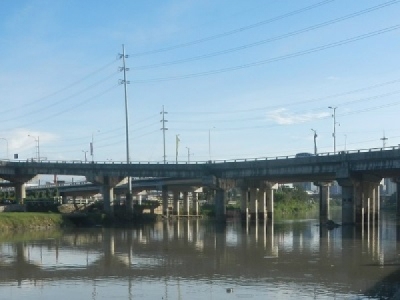
Posted on October 4, 2018
SETTING a contrast in the heavy traffic of vehicles above the Marcos bridge, was a calm Cagayan river one afternoon Friday, September 28.
It was a low tide, and no signs of rainfall throughout the day or evening. In the riverside along Barangay Consolacion, there were wide, barge-like boats docked, some trucks parked, and men shoveling sands – black sands – “Class A.”
While some men were busy loading sands, Richard Villaver, in his 40s, was busy repairing a boat with new lightweight metal sheets.
“This would cost you around P30,000,” he said in Bisaya. Referring to the total value of the boat he repaired. The boats were used to transport the black sands from Cagayan river, whom Villaver and his fellows manually get by diving the depths of the water carrying only but plastic or metal containers.
Villaver was born and raised in Consolacion, and for 16 years, manual sand quarrying has been his livelihood. Even if floods caused by storms that sometimes destroy their boats and houses, they keep on coming back and resume their means of living.
“Our house now is in Barangay Pagatpat (relocation site), the ones you see here (makeshift quarters) are temporary, because this is where we work most of the time,” he said.
When the storm “Sendong,” hit Cagayan de Oro City with flood that destroyed lives and houses, Villaver was among those who were affected, thus, he and his family was among those who were given a relocation house thereafter.
Because of the flooding incidents that have occurring frequently, government agencies have formulated measures to address different issues concerning environmental protection, and disaster risk preparedness. This is something Villaver and his group would encounter over time, affecting their means of living.
In his early years, Villaver recalled that they can quarry freely with less restriction or regulation from the government.
However, there was a time it became hard for them when in 2014, the Department of Public Works and Highways (DPWH) central office has issued the Department Order (DO) 139 that set the guidelines on river dredging operations for flood control.
The order comes after the Mining Industry Coordinating Council Resolution Number 4 dated May 30, 2014, which was also aligned to the Implementing Rules and Regulations of the Water Code of the Philippines under the Presidential Decree 1067. In essence, DPWH was given direct supervision and control of dredging activities near the river deltas in the country.
Under the DO, it is forbidden to do quarry or dredging activities about one kilometer distance from any public or private works or structure. This has become a dilemma for Villaver and his group, as the stretch of the river where they get the sands is situated between three bridges: Ysalnia “Carmen” Bridge, Marcos bridge, and the Puntod-Kauswagan bridge.
DPWH in Northern Mindanao, was given the authority to do dredging activities, in order to make river delta deep and avoid immediate flooding when the waters coming from the Bukidnon tributaries run through the rivers of Cagayan de Oro City.
By operation, dredging and quarrying have the similar process of extracting sand and gravel in rivers, except by definition in which in dredging activities, the sands – or as what the DPWH refer as “spoils,” are left in the coastlines, or give it to local government units to be used as additional infrastructure material.
Engineer John Lennon Felisarta, Engineer-2 of DPWH-10 detailed in the area, clarified that DPWH has no police powers or enforcement to call out the local groups quarrying in the area, thus they sought assistance with the City Local Environment and Natural Resources Office (Clenro) and the Environmental Management Bureau (EMB) of the Department of Environment and Natural Resources (DENR).
“Before, we dredged those areas (near the bridges), and we saw some of them getting the spoils,” he said, adding that the spoils can be a natural flood control mechanism.
But this is not only the choke point Villaver and his group were able to face; among their community, there were issues that had to be ironed out…
Source: SunStar





